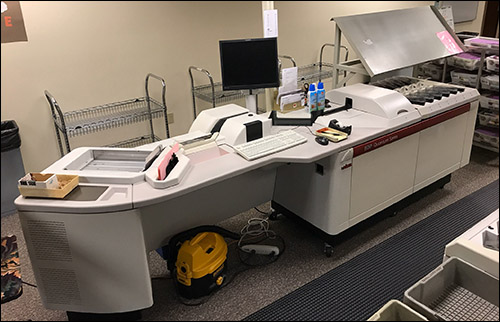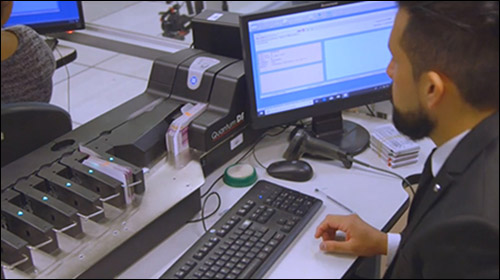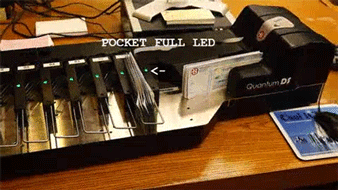Related articles in this series: Scanner duty cycles and lifespan | Mexican payroll coupons
When it comes to production capture and sorting of documents, few companies have a bigger job to do than Compañía Mexicana de Procesamiento S.A. de C.V.
The Mexico City-based firm – also known as CMP for short – opened its doors in 1997 as a collaboration between the country’s two biggest banks, Banamex (now Citigroup) and BBVA, to streamline their check handling operations. From that beginning, CMP has steadily expanded into business process outsourcing (BPO), with a focus on production document capture and storage.

The scale of CMP’s operations is enormous: Between two main processing centers and ten satellite offices, it scans and organizes more than a million documents per day, working in three shifts around the clock. Its archives contain more than 10 billion images captured on behalf of its clients. It is one of the largest back-office sorting operations in the world. And at the center of this operation is a powerful but precarious link – a set of Burroughs Unisys NDP 850 and NDP 1150 reader/sorters that are quickly approaching the end of their service lifetimes.
The NDPs are some of the fastest sorting machines ever built, capable of processing 1,150 items per minute into 36 separate exit pockets. (Other NDP models even went as high as 2,000 documents per minute.) These “big iron” sorting machines – the size of a room and weighing more than a ton – first came into widespread use in the 1970s, and nothing since then has ever come close to matching their speed. CMP Director Francisco Ayala says his company purchased their current reader/sorters in 2008, and since then, he estimates about 1.1 billion documents have been scanned on each machine.
But the reader/sorter is a relic of a past age – CMP’s were among the last ever built. The final high-speed reader/sorter manufacturer quit making the machines in 2013, and options are running out for those who still use them. Virtually all makes and models are at the end of their support lifetimes, with OEM parts and service being cut off in 2020 or 2021. Maintenance had been expensive already; now it is simply becoming unavailable. “It is very, very difficult to get new parts,” Ayala says.
Discontinued with No Replacement

A major problem left unaddressed by the end of the support of these reader/sorters was that a direct replacement for those giant machines simply didn’t exist. While desktop check scanners have become much faster and more accurate over time, the sheer volume of paper being processed by companies like CMP is simply far more than an ordinary scanner is designed to handle (see sidebar).
There’s also another twist: CMP doesn’t just do straightforward check capture – it also handles other types of documents including Mexican payroll vouchers (see second related sidebar), and often needs to sort many items depending on their clearing destinations. Single-pocket scanners, and even two-pocket devices, are severely limited in these environments – but that’s just about the only way that “modern” check scanners are designed.
To make up for the impending loss of its reader/sorters, CMP turned to the Quantum DS, Digital Check’s high-speed tabletop check transport. Originally introduced in 2013, the QDS was intended to bridge the significant gap in capabilities between the outgoing Big Iron machines and the relatively light-duty scanners available to replace them. With 12 high-capacity pockets and continuous high-speed feeding capability, the Quantum DS was able to take over the jobs that the smaller devices simply couldn’t do.
“As an intermediate step between a full-sized reader/sorter and an ordinary scanner, the Quantum DS has been invaluable to us,” Ayala says. “There is no other machine quite like it today.”
More Pockets Aren’t Just for Sorting

It’s easy to look at a check transport with 12 pockets and conclude that the only use for them is separating documents into various categories. They have another, less obvious benefit, though. Even when the Quantum DS isn’t doing any sorting at all, the extra space lets the machine run continuously for a very long time.
If the documents being scanned don’t need to be sorted in any particular order, the QDS can use “waterfall pocketing” – that is, filling up one exit pocket, then moving on to the next without stopping. Since the input feeder also allows for adding more items while the machine is running, it can hold up to 2,400 checks (200 items x 12 pocket) before it needs to be emptied. Compared to light-duty scanners’ typical capacity of 150 or 200 documents per batch, this gives the QDS a huge advantage in “wall clock” speed.
What’s more, waterfall pocketing also allows the operator to empty previous pockets on the Quantum DS once it has started filling up the next one. That means it can run at 200 documents per minute almost indefinitely – as long as the operator can keep up.
For some of CMP’s smaller centers, an ordinary bank-type scanner can do the job; the company currently uses Digital Check’s BX7200 branch capture scanners for the purpose. But when you’re dealing with a million documents per day, the difference between that and a true production-level capture machine is compelling.
Conquering an Overwhelming Expense
The pressure for CMP to replace its aging NDP machines is not just because it’s hard to find parts and support – the expense of operating them has also become cost-prohibitive. Ayala says his company paid about $365,000 each for its most recent pair of reader/sorters back in 2008. But upkeep on the machines has been even higher: Around $37,500 per year for each machine. (That’s nearly double the list price for a brand-new Quantum DS.) That price tag also doesn’t include internal operations costs, such as a controlled environment or the specialized training and dedicated staff needed to run the devices.
“Not all employees are capable of operating our NDP machines – a specific profile and training is required,” Ayala explains. “It is three weeks of training, and we have an engineer onsite to provide support for the Unisys sorters. For service, we rely on an outsourced employee.”
Another lesser known, but increasingly urgent, issue with the upcoming end of OEM support for the NDP machines is that replacement parts for these machines aren’t like parts for other machines. The nature of Big Iron devices means key components are often made of special materials or milled with incredible precision approaching 0.01 mm.
Besides making the components expensive, these special requirements usually mean there are no third-party suppliers making reader/sorter replacement parts. If you can’t get them from the original manufacturer, you can’t get them at all. When the sun finally sets on OEM service and support, it will be a hard stop for most Big Iron operators. Nonetheless, the capabilities of the big machines had proven compelling enough for Ayala to keep them in service until there was no other choice.
“There are very few other devices available today that fit this profile,” he says. “That is the major reason why we have kept the older NDP machines in service.”
CMP currently operates eight Quantum DS machines in its central offices, with plans to finally replace the remaining NDP series devices by 2021. Some small changes in procedure have made the transition go smoothly so far, Ayala says. Running multiple QDS machines in parallel, for example, can get the sorting done nearly as fast, and 12 pockets are sufficient for all check jobs and most coupon batches.
Most importantly, Ayala knows that he’ll be able to rely on the Quantum DS for years to come. Since it shares many parts in common with other Digital Check SmartSource scanner models for the teller window, obtaining service is easy, and parts are cost-effective and readily available.
“I am looking for a few important qualities in the capture equipment we use: High speed of reading; low maintenance costs; high availability of spare parts; a heavy-duty device; and a low level of rejections,” Ayala said. “The Quantum DS has stepped in to fill a very big gap that the large reader/sorters left behind.”





